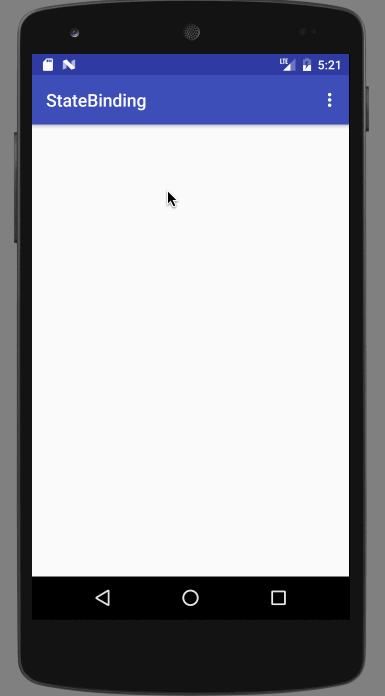您好,登錄后才能下訂單哦!
您好,登錄后才能下訂單哦!
寫在前面
在平時的開發之中,我們需要對于數據加載的情況進行展示:
現在設置頁面狀態的方式有多種,由于筆者近期一直在使用databinding,而數據綁定通過改變模型來展示view的方式和狀態頁的設置也滿契合的。
所以這里就講講使用databinding來設置android中的各種狀態頁。很簡單,先看看效果

首先
在app的build.gradle文件中開啟databinding
android{
...
dataBinding {
enabled = true
}
}
我們先定義一些用于狀態的注解EmptyState
/**
* 頁面描述:空狀態
* <p>
* Created by ditclear on 2017/2/24.
*/
@IntDef({NORMAL, PROGRESS, EMPTY, NET_ERROR, NOT_AVAILABLE})
@Retention(RetentionPolicy.SOURCE)
public @interface EmptyState {
int NORMAL = -1; //正常
int PROGRESS = -2;//顯示進度條
int EMPTY = 11111; //列表數據為空
int NET_ERROR = 22222; //網絡未連接
int NOT_AVAILABLE = 33333; //服務器不可用
//...各種頁面的空狀態,可以自己定義、添加
}
再自定義一個異常EmptyException用于顯示我們需要的狀態信息
/**
* 頁面描述:異常
* <p>
* Created by ditclear on 2017/3/5.
*/
public class EmptyException extends Exception {
private int code;
public EmptyException(@EmptyState int code) {
super();
this.code = code;
}
@EmptyState
public int getCode() {
return code;
}
public void setCode(@EmptyState int code) {
this.code = code;
}
}
現在,大多數展示狀態頁的控件都會提供
所以我們的目標也是顯示這些
布局
以數據綁定的形式進行布局,使用StateModel來控制狀態頁展示的消息
<?xml version="1.0" encoding="utf-8"?>
<layout xmlns:android="http://schemas.android.com/apk/res/android"
>
<data>
<import type="android.view.View"/>
<variable
name="stateModel"
type="com.ditclear.app.state.StateModel"/>
</data>
<RelativeLayout
android:id="@+id/rv_empty_view"
android:layout_width="match_parent"
android:layout_height="match_parent"
android:background="@color/background"
android:clickable="true"
android:focusableInTouchMode="true"
android:visibility="@{stateModel.empty?View.VISIBLE:View.GONE}">
<android.support.v4.widget.ContentLoadingProgressBar
android:layout_width="wrap_content"
android:layout_height="wrap_content"
android:layout_centerInParent="true"
android:visibility="@{stateModel.progress?View.VISIBLE:View.GONE}"/>
<LinearLayout
android:layout_width="match_parent"
android:layout_height="match_parent"
android:layout_alignParentBottom="true"
android:layout_alignParentLeft="true"
android:layout_alignParentStart="true"
android:gravity="center"
android:orientation="vertical"
android:visibility="@{stateModel.progress?View.INVISIBLE:View.VISIBLE}">
<ImageView
android:id="@+id/none_data"
android:layout_width="345dp"
android:layout_height="180dp"
android:scaleType="fitCenter"
android:src="@{stateModel.emptyIconRes}"/>
<TextView
android:layout_width="wrap_content"
android:layout_height="25dp"
android:layout_below="@+id/none_data"
android:layout_centerHorizontal="true"
android:text="@{stateModel.currentStateLabel}"
android:textSize="16sp"/>
</LinearLayout>
</RelativeLayout>
</layout>
布局文件中有幾個方法
我們定義狀態的ViewModel ,就叫StateModel,來控制狀態
/**
* 頁面描述:狀態頁面設置模型
* <p>
* Created by ditclear on 2017/2/24.
*/
public class StateModel extends BaseObservable {
private Context mContext = MyApp.instance();
@EmptyState
private int emptyState = EmptyState.NORMAL;
private boolean empty;
public int getEmptyState() {
return emptyState;
}
/**
* 設置狀態
*
* @param emptyState
*/
public void setEmptyState(@EmptyState int emptyState) {
this.emptyState = emptyState;
notifyChange();
}
/**
* 顯示進度條
*
* @return
*/
public boolean isProgress() {
return this.emptyState == EmptyState.PROGRESS;
}
/**
* 根據異常顯示狀態
*
* @param e
*/
public void bindThrowable(Throwable e) {
if (e instanceof EmptyException) {
@EmptyState
int code = ((EmptyException) e).getCode();
setEmptyState(code);
}
}
public boolean isEmpty() {
return this.emptyState != EmptyState.NORMAL;
}
/**
* 空狀態信息
*
* @return
*/
@Bindable
public String getCurrentStateLabel() {
switch (emptyState) {
case EmptyState.EMPTY:
return mContext.getString(R.string.no_data);
case EmptyState.NET_ERROR:
return mContext.getString(R.string.please_check_net_state);
case EmptyState.NOT_AVAILABLE:
return mContext.getString(R.string.server_not_avaliabe);
default:
return mContext.getString(R.string.no_data);
}
}
/**
* 空狀態圖片
*
* @return
*/
@Bindable
public Drawable getEmptyIconRes() {
switch (emptyState) {
case EmptyState.EMPTY:
return ContextCompat.getDrawable(mContext, R.drawable.ic_visibility_off_green_400_48dp);
case EmptyState.NET_ERROR:
return ContextCompat.getDrawable(mContext, R.drawable.ic_signal_wifi_off_green_400_48dp);
case EmptyState.NOT_AVAILABLE:
return ContextCompat.getDrawable(mContext, R.drawable.ic_cloud_off_green_400_48dp);
default:
return ContextCompat.getDrawable(mContext, R.drawable.ic_visibility_off_green_400_48dp);
}
}
}
很普通的視圖模型,主要有幾個用于判斷狀態顯示的方法
下面講講實際運用:
在activity或者fragment布局中,添加狀態頁的布局
<?xml version="1.0" encoding="utf-8"?>
<layout xmlns:android="http://schemas.android.com/apk/res/android"
xmlns:app="http://schemas.android.com/apk/res-auto">
<data>
<import type="android.view.View"/>
<variable
name="stateModel"
type="com.ditclear.app.state.StateModel"/>
</data>
<com.ditclear.app.ScrollChildSwipeRefreshLayout
android:id="@+id/refresh_layout"
android:layout_width="match_parent"
android:layout_height="match_parent">
<RelativeLayout
android:id="@+id/container"
android:layout_width="match_parent"
android:layout_height="match_parent"
android:orientation="vertical">
<android.support.v4.widget.NestedScrollView
android:layout_width="match_parent"
android:layout_height="match_parent"
android:fillViewport="false"
android:overScrollMode="always"
android:visibility="@{stateModel.empty?View.GONE:View.VISIBLE}">
<TextView
android:id="@+id/content_tv"
android:layout_width="match_parent"
android:layout_height="match_parent"
android:gravity="center"/>
</android.support.v4.widget.NestedScrollView>
<include
layout="@layout/widget_layout_empty"
app:stateModel="@{stateModel}"/>
</RelativeLayout>
</com.ditclear.app.ScrollChildSwipeRefreshLayout>
</layout>
最后在activity或者fragment中我們只需要通過state.bindThrowable()和state.setEmptyState()方法便可以輕松設置各種各樣的狀態。
loadData().subscribe(new Subscriber<List<Contributor>>() {
@Override
public void onStart() {
super.onStart();
if (!mMainBinding.refreshLayout.isRefreshing()) {
mStateModel.setEmptyState(EmptyState.PROGRESS);
}
}
@Override
public void onCompleted() {
mStateModel.setEmptyState(EmptyState.NORMAL);
}
@Override
public void onError(Throwable e) {
mMainBinding.refreshLayout.setRefreshing(false);
mStateModel.bindThrowable(e);
Toast.makeText(MainActivity.this, mStateModel.getCurrentStateLabel(), Toast.LENGTH_SHORT).show();
}
@Override
public void onNext(List<Contributor> contributors) {
mMainBinding.refreshLayout.setRefreshing(false);
if (contributors == null || contributors.isEmpty()) {
onError(new EmptyException(EmptyState.EMPTY));
} else {
mMainBinding.contentTv.setText(contributors.toString());
}
}
});
寫在最后
對于要使用數據來控制視圖狀態的,使用databinding實在是一個事半功倍的方式。而且也十分容易理解。
最后demo地址:StateBinding_jb51.rar
以上就是本文的全部內容,希望對大家的學習有所幫助,也希望大家多多支持億速云。
免責聲明:本站發布的內容(圖片、視頻和文字)以原創、轉載和分享為主,文章觀點不代表本網站立場,如果涉及侵權請聯系站長郵箱:is@yisu.com進行舉報,并提供相關證據,一經查實,將立刻刪除涉嫌侵權內容。